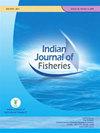Productivity, energy use efficiency, economics and CO2 emission from integrated fish-duck farming in floodplain wetland ecosystems of eastern India
IF 0.3
4区 农林科学
Q4 FISHERIES
引用次数: 0
Abstract
The study aims to assess productivity, economics, energy use efficiency and CO2e emissionfrom integrated fish-duck farming system (IFDF system) in floodplains of the eastern India.A total of six fish ponds were constructed and developed as IFDF system under floodplainsin which fingerlings were stocked @4000 acre-1 and integrated with 150 numbers of KhakiCampbell ducks. Average growth rate of fishes ranged from 27 g month-1 of mrigal to 31.7 gmonth-1 of grass carp and average body weight ranged from 465.2 g of mrigal to 823.2 gof grass carp. The fish equivalent yield was obtained as 3.06 t acre-1 year-1. The total energyinput, output and energy use efficiency ratio estimated were 111.8 GJ and 21.2 GJ and 0.19,respectively. Net income earned was ₹234393 acre-1 year-1 and BC ratio estimated was 1.91.Further, 0.56 kg CO2e was emitted to produce 1.0 kg of fish equivalent, which was muchlower than that of the production of rice, mutton and milk. Keywords:CO2e emission, Economics, Energy, Fish-duckfarming, Floodplain, Productivity印度东部洪泛湿地生态系统鱼鸭综合养殖的生产力、能源利用效率、经济性和二氧化碳排放量
该研究旨在评估印度东部洪泛平原鱼鸭综合养殖系统(IFDF 系统)的生产率、经济效益、能源利用效率和二氧化碳排放量。在洪泛平原共建造和开发了 6 个鱼塘作为 IFDF 系统,其中按 4000 英亩-1 的比例投放鱼苗,并与 150 只卡其-坎贝尔鸭相结合。鱼类的平均生长率从胭脂鱼的 27 克/月-1 到草鱼的 31.7 克/月-1 不等,平均体重从胭脂鱼的 465.2 克到草鱼的 823.2 克不等。鱼当量产量为 3.06 吨/英亩-年-1。估计的总能源投入、产出和能源利用效率分别为 111.8 千兆焦、21.2 千兆焦和 0.19。此外,生产 1.0 千克鱼当量需排放 0.56 千克 CO2e,远低于大米、羊肉和牛奶的产量。关键词:CO2e 排放 经济学 能源 养殖鱼鸭 洪泛区 生产率
本文章由计算机程序翻译,如有差异,请以英文原文为准。
求助全文
约1分钟内获得全文
求助全文
来源期刊

Indian Journal of Fisheries
FISHERIES-
CiteScore
0.90
自引率
20.00%
发文量
0
审稿时长
6-12 weeks
期刊介绍:
Indian Journal of Fisheries is published quarterly by the Indian Council of Agricultural Research (ICAR), New Delhi. Original contributions in the field of Fish and fisheries science are considered for publication in the Journal. The material submitted must be unpublished and not under consideration for publication elsewhere.
Papers based on research which kills or damages any species, regarded as thratened/ endangered by IUCN crieteria or is as such listed in the Red Data Book appropriate to the geographic area concerned, will not be accepted by the Journal, unless the work has clear conservation objectives.
 求助内容:
求助内容: 应助结果提醒方式:
应助结果提醒方式:


